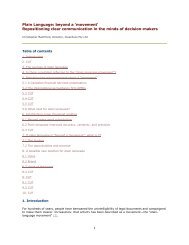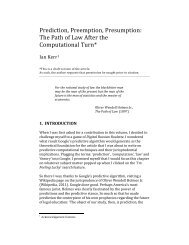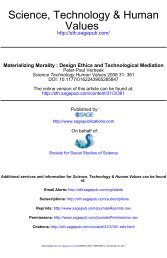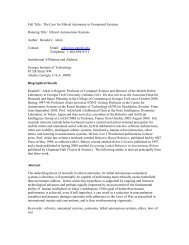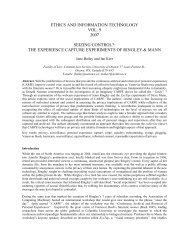'Asimov's Laws of Robotics' - the Laws of Robotics 2013
'Asimov's Laws of Robotics' - the Laws of Robotics 2013
'Asimov's Laws of Robotics' - the Laws of Robotics 2013
- No tags were found...
Create successful ePaper yourself
Turn your PDF publications into a flip-book with our unique Google optimized e-Paper software.
Roger Clarke's <strong>'Asimov's</strong> <strong>Laws</strong> <strong>of</strong> <strong><strong>Robotics</strong>'</strong><strong>2013</strong>-09-03 10:33 AMcomparative advantages. Information technologists must delineate <strong>the</strong> relationship between robots and peopleby applying <strong>the</strong> concept <strong>of</strong> decision structuredness to blend computer- based and human elementsadvantageously. The goal should be to achieve complementary intelligence ra<strong>the</strong>r than to continue pursuing<strong>the</strong> chimera <strong>of</strong> unneeded artificial intelligence. As Wyndham put it in 1932: "Surely man and machine arenatural complements: They assist one ano<strong>the</strong>r." 21Risk managementWhe<strong>the</strong>r or not subjected to intrinsic laws or design guidelines, robotics embodies risks to property as well asto humans. These risks must be managed; appropriate forms <strong>of</strong> risk avoidance and diminution need to beapplied, and regimes for fallback, recovery, and retribution must be established.Controls are needed to ensure that intrinsic laws, if any, are operational at all times and that guidelines fordesign, development, testing, use, and maintenance are applied. Second- order control mechanisms areneeded to audit first- order control mechanisms. Fur<strong>the</strong>rmore, those bearing legal responsibility for harmarising from <strong>the</strong> use <strong>of</strong> robotics must be clearly identified. Courtroom litigation may determine <strong>the</strong> actualamount <strong>of</strong> liability, but assigning legal responsibilities in advance will ensure that participants take due care.In most <strong>of</strong> Asimov's robot stories, robots are owned by <strong>the</strong> manufacturer even while in <strong>the</strong> possession <strong>of</strong>individual humans or corporations. Hence legal responsibility for harm arising from robot noncompliancewith <strong>the</strong> laws can be assigned with relative ease. In most real- world jurisdictions, however, <strong>the</strong>re areenormous uncertainties, substantial gaps in protective coverage, high costs, and long delays.Each jurisdiction, consistent with its own product liability philosophy, needs to determine who should bear<strong>the</strong> various risks. The law must be sufficiently clear so that debilitating legal battles do not leave injuredparties without recourse or sap <strong>the</strong> industry <strong>of</strong> its energy. Information technologists need to communicate tolegislators <strong>the</strong> importance <strong>of</strong> revising and extending <strong>the</strong> laws that assign liability for harm arising from <strong>the</strong>use <strong>of</strong> information technology.Enhancements to codes <strong>of</strong> ethicsAssociations <strong>of</strong> information technology pr<strong>of</strong>essionals, such as <strong>the</strong> lEEE Computer Society, <strong>the</strong> Associationfor Computing Machinery, <strong>the</strong> British Computer Society, and <strong>the</strong> Australian Computer Society, areconcerned with pr<strong>of</strong>essional standards, and <strong>the</strong>se standards almost always include a code <strong>of</strong> ethics. Suchcodes aren't intended so much to establish standards as to express standards that already exist informally.None<strong>the</strong>less, <strong>the</strong>y provide guidance concerning how pr<strong>of</strong>essionals should perform <strong>the</strong>ir work, and <strong>the</strong>re issignificant literature in <strong>the</strong> area.The issues raised in this article suggest that existing codes <strong>of</strong> ethics need to be reexamined in <strong>the</strong> light <strong>of</strong>developing technology. Codes generally fail to reflect <strong>the</strong> potential effects <strong>of</strong> computer- enhanced machinesand <strong>the</strong> inadequacy <strong>of</strong> existing managerial, institutional, and legal processes for coping with inherent risks.Information technology pr<strong>of</strong>essionals need to stimulate and inform debate on <strong>the</strong> issues. Along with robotics.many o<strong>the</strong>r technologies deserve consideration. Such an endeavor would mean reassessing pr<strong>of</strong>essionalism in<strong>the</strong> light <strong>of</strong> fundamental works on ethical aspects <strong>of</strong> technology.http://www.rogerclarke.com/SOS/Asimov.htmlPage 25 <strong>of</strong> 30



